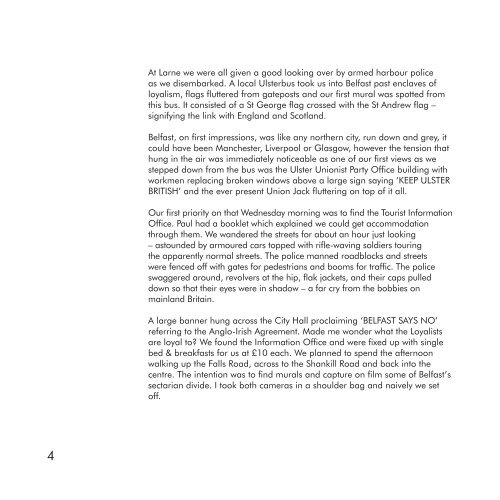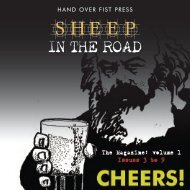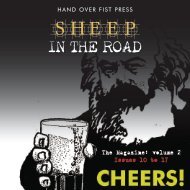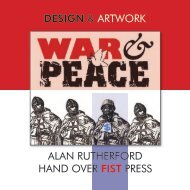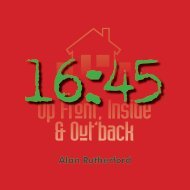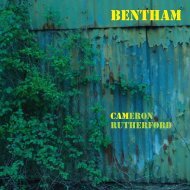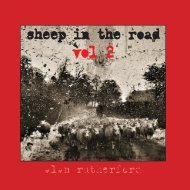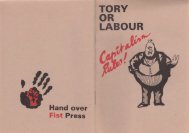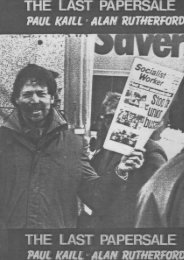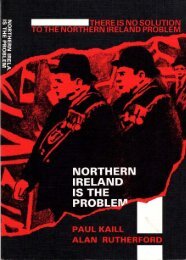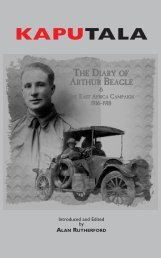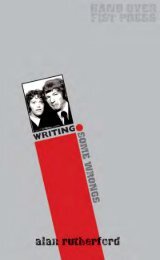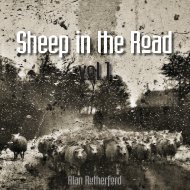Irish Graffiti: Some Murals in the North, 1986.pdf
The photographs in this book were taken on a very short trip to the North of Ireland and represent a snapshot of that time, 4–8 November 1986. They were to convey my interest in the political murals on display there ... and came by way of my fascination for the street art of the Constructivists in early revolutionary Russia. Even though there seems to be a concensus that peace has arrived in the troubled communities of Northern Ireland, its veneer is as thin as the fact these territorial markers, these political statements, these magnificently diverse graffiti are still adorning unionist/protestant and nationalist/catholic neighbourhoods. Seldom considered respectable or ‘art’, graffiti cannot be ignored. Immediate, rebelious, public, confrontational, honest, malicious, political, vulgar, informative, territorial and in your face broadcasting of opinions, ideas ... and usually anonymous. This has been a constant expression for the talented and talentless since human stirrings, welcome or unwelcome depending on your viewpoint. Graffiti comes from the same loadstone as ‘high art’, but because of its egalitarian and anti-establishment nature it subverts ‘high art’ and ‘the artist’ modes of recognised celebrity and value by undermining and one-finguring ‘high art’s elitist and posturing nepotism.
The photographs in this book were taken on a very short trip to the North of Ireland and represent a snapshot of that time, 4–8 November 1986. They were to convey my interest in the political murals on display there ... and came by way of my fascination for the street art of the Constructivists in early revolutionary Russia.
Even though there seems to be a concensus that peace has arrived in the troubled communities of Northern Ireland, its veneer is as thin as the fact these territorial markers, these political statements, these magnificently diverse graffiti are still adorning unionist/protestant and nationalist/catholic neighbourhoods.
Seldom considered respectable or ‘art’, graffiti cannot be ignored. Immediate, rebelious, public, confrontational, honest, malicious, political, vulgar, informative, territorial and in your face broadcasting of opinions, ideas ... and usually anonymous. This has been a constant expression for the talented and talentless since human stirrings, welcome or unwelcome depending on your viewpoint.
Graffiti comes from the same loadstone as ‘high art’, but because of its egalitarian and anti-establishment nature it subverts ‘high art’ and ‘the artist’ modes of recognised celebrity and value by undermining and one-finguring ‘high art’s elitist and posturing nepotism.
Create successful ePaper yourself
Turn your PDF publications into a flip-book with our unique Google optimized e-Paper software.
At Larne we were all given a good look<strong>in</strong>g over by armed harbour police<br />
as we disembarked. A local Ulsterbus took us <strong>in</strong>to Belfast past enclaves of<br />
loyalism, flags fluttered from gateposts and our first mural was spotted from<br />
this bus. It consisted of a St George flag crossed with <strong>the</strong> St Andrew flag –<br />
signify<strong>in</strong>g <strong>the</strong> l<strong>in</strong>k with England and Scotland.<br />
Belfast, on first impressions, was like any nor<strong>the</strong>rn city, run down and grey, it<br />
could have been Manchester, Liverpool or Glasgow, however <strong>the</strong> tension that<br />
hung <strong>in</strong> <strong>the</strong> air was immediately noticeable as one of our first views as we<br />
stepped down from <strong>the</strong> bus was <strong>the</strong> Ulster Unionist Party Office build<strong>in</strong>g with<br />
workmen replac<strong>in</strong>g broken w<strong>in</strong>dows above a large sign say<strong>in</strong>g ‘KEEP ULSTER<br />
BRITISH’ and <strong>the</strong> ever present Union Jack flutter<strong>in</strong>g on top of it all.<br />
Our first priority on that Wednesday morn<strong>in</strong>g was to f<strong>in</strong>d <strong>the</strong> Tourist Information<br />
Office. Paul had a booklet which expla<strong>in</strong>ed we could get accommodation<br />
through <strong>the</strong>m. We wandered <strong>the</strong> streets for about an hour just look<strong>in</strong>g<br />
– astounded by armoured cars topped with rifle-wav<strong>in</strong>g soldiers tour<strong>in</strong>g<br />
<strong>the</strong> apparently normal streets. The police manned roadblocks and streets<br />
were fenced off with gates for pedestrians and booms for traffic. The police<br />
swaggered around, revolvers at <strong>the</strong> hip, flak jackets, and <strong>the</strong>ir caps pulled<br />
down so that <strong>the</strong>ir eyes were <strong>in</strong> shadow – a far cry from <strong>the</strong> bobbies on<br />
ma<strong>in</strong>land Brita<strong>in</strong>.<br />
A large banner hung across <strong>the</strong> City Hall proclaim<strong>in</strong>g ‘BELFAST SAYS NO’<br />
referr<strong>in</strong>g to <strong>the</strong> Anglo-<strong>Irish</strong> Agreement. Made me wonder what <strong>the</strong> Loyalists<br />
are loyal to? We found <strong>the</strong> Information Office and were fixed up with s<strong>in</strong>gle<br />
bed & breakfasts for us at £10 each. We planned to spend <strong>the</strong> afternoon<br />
walk<strong>in</strong>g up <strong>the</strong> Falls Road, across to <strong>the</strong> Shankill Road and back <strong>in</strong>to <strong>the</strong><br />
centre. The <strong>in</strong>tention was to f<strong>in</strong>d murals and capture on film some of Belfast’s<br />
sectarian divide. I took both cameras <strong>in</strong> a shoulder bag and naively we set<br />
off.<br />
4


